|
Vira (Platt) & Willard Talmage
contributed by her daughters, Judy and Martha |
||||||||||||||||||||||||||||||
|
Vira Pearl Platt Talmage was the 9th child, born on March 6, 1904, three years before Oklahoma became a state. At the time of her birth she was given the name Annie Campbell. A few years later another daughter was born, at which time the newest baby was named Annie Campbell (and called Annabel), and she was re-named Vira Pearl (And always called Vi). Both sisters remember this change in a negative manner, with Vira believing that her father thought the newer baby was prettier and more deserving of this pretty name, which honored both parents. Annabel didn't like her name; she believed that their parents considered the name 'Annabel' to be ugly and unfit for the older and more deserving child.
|
||||||||||||||||||||||||||||||
| Vi graduated from high school in Stillwater in 1923 and enrolled at Oklahoma A&M College (now Oklahoma State University). She took all the courses that interested her and loved and participated in many extracurricular activities. She was captain of the rifling team and loved her horticulture and landscaping classes. At this time a person could receive a teaching certificate with a high school diploma, and Vi began to teach after her first year of college. One of her brothers had suggested that she apply for a teaching certificate and she was enthused about the idea. After she secured a position she asked the principal, "How much are you going to ask for this?" and he asked what she meant. After a brief discussion she was surprised to learn that she would be paid for doing something so enjoyable! She taught in a one-room school, and among her pupils were rough men as old as she was and tiny little first grade girls. With her income from teaching, Vi continued her education at Oklahoma A&M College in 1926. She would attend a year of college and then teach for another year. She also attended summer school at the University of Wisconsin in Madison, where she enjoyed canoeing, and the University of Southern California, where she invited two of her sisters out to visit her. She tells of wanting to impress some young men she met in California and she felt that being a teacher from Oklahoma was just not intriguing enough. Recalling a poster on a bus she had seen en route, she told them she was |
||||||||||||||||||||||||||||||
 |
||||||||||||||||||||||||||||||
|
One of Vira's first schools
|
||||||||||||||||||||||||||||||
| a "comptometer operator."A short while later, in the office where one of them worked, she pointed to an unusual piece of equipment and asked what it was. "A comptometer" she was told, to her very great embarrassment. Her daughters speculate that this was probably the only lie she ever told. While teaching at her very first school, Vi lived with Wella and Jim Nixon, and Arlie Nixon was in her very first class of students. Arlie remembers pretending to be asleep one night and overhearing his Dad ask Vi if she was having any problems. She told him that Arlie had been only kid to give her any trouble. Jim told her to whip him the next time he deserved it, so the very next day Arlie was "himself" and Vi told him to go cut a switch for a whipping. He came back in with the switch and said " You aren't REALLY going to whip me are you, Aunt Vi?" with tears in his voice. She just couldn't do it and he laughs about it to this day! Vi said repeatedly that Arlie was the worst boy she ever had in class and her daughters never doubted her word! |
||||||||||||||||||||||||||||||
| After some very poor experiences with the country schools, Vi determined to find a job in a city school and found one in Jenks, Oklahoma in 1928. She was the proud owner of a real cute little Ford Model A, with a "rumble seat" and had several beaus. While there, Vi happened to eat at a local cafe operated by the Talmage family and known for serving excellent chili. She liked the Talmages and met their son, Willard, who worked for the Baltimore and Ohio Railroad in Tulsa, but helped in the café on weekends. Willard and Vi began to date. |
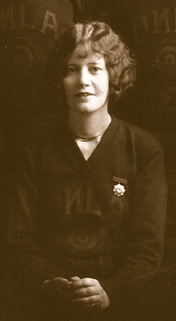 |
|||||||||||||||||||||||||||||
| Vi dated Willard during 1929 and 1930. In 1929, Vi graduated from OSU with her degree in Teaching and on graduation week-end, Willard gave her an engagement ring. She gave him the ring back at the end of 1930 and Willard's family believed it was because of a pilot Vi had dated named L. V. Muzzy. Muzzy had pursued her for several years and often gave her unsolited gifts. Five years later, in August of 1935, Vi went to California to visit Margaret and have some vacation. While she was there, Will Rogers died and they attended his funeral service at the Hollywood Bowl and stood in line forever to view his body at Forest Lawn. Margaret took her to a fortune-teller one night who told her she was still in love with an old flame. Vi knew just who she | ||||||||||||||||||||||||||||||
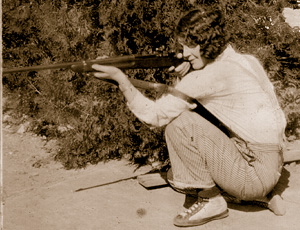 |
||||||||||||||||||||||||||||||
|
On the Oklahoma A&M rifling team......
|
||||||||||||||||||||||||||||||
|
... and basketball team
|
||||||||||||||||||||||||||||||
| meant, and wasted no time in returning to Oklahoma to look for Willard. They began dating the first of September, 1935 and eventually they married on June 1, 1938, almost 10 years after they first met. | ||||||||||||||||||||||||||||||
| Vira had a lot of musical talent. She had learned to play the steel guitar, the ukulele, the piano, and other instruments in her twenties, and was often asked to play. In these days people had little access to recorded music, and playing and singing were popular pastimes. Vi kept a journal for MANY years, and often mentioned "went for a ride in my Ford, took my uke and we sang". She and her sisters, Annabelle and Nora, performed at Church socials and school events. In later years, during family gatherings she was often asked to play hymns on the piano while her brothers and sisters gathered around the piano to sing. When her daughters were young they remember watching Vira write down numbers as she listened to music. Then she could go to the piano and reproduce the music by playing the chord numbers she had written. They thought it was magic! | ||||||||||||||||||||||||||||||
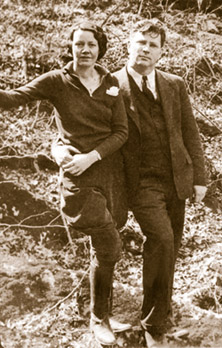 |
When they married, Willard was working for Phillips Petroleum in Bartlesville, and Vi had been teaching at Barnard Grade School in Tulsa. The couple rented a bedroom in Bartlesville from Mr. and Mrs. Ernon Hathaway who remained lifelong friends. In the summer of 1939, Vi and Willard made a belated honeymoon trip to Niagara Falls, on their first wedding anniversary. That same year they moved into a new home at 2042 S. Osage, Bartlesville, where they lived throughout their married life. (The original mortgage papers for this pre-war home show the purchase price was $3700, with monthly payments of $22).The residence was one of the first built on the new street, but new homes were built rapidly and were quickly occupied by other couples that were starting families. It was a stable neighborhood and few people ever moved into or away from the neighborhood once the homes were built and occupied. Their home was a small frame house, with two bedrooms and one bathroom, and with a detached one-car garage.Willard dug out the crawlspace an area under the back bedroom and made a cement staircase and opening from the backyard so that there was a basement. When the children were tiny, ice for the icebox was stored in the basement. Vi canned vegetables and fruits, and the jars were stored on shelves in the basement for many years! (Martha remembers that when the house was sold in the mid 70's, there was a jar of beans on the shelf dated 1948 that Grandmother had canned.) The basement always had a damp and musty smell and lots of Daddy Long Legs spiders and the girls didn't really like to go down there. | |||||||||||||||||||||||||||||
| Vi had taken horticulture classes in college, and she drew out plans for the backyard. Most of the neighbors had open, unfenced back yards, with a tree or a few shrubs. Her yard had a lovely white picket fence around it, with two peach trees, | ||||||||||||||||||||||||||||||
| a pear tree, a cherry tree, two pine trees, two weeping willow trees (Vi was quietly tearful when she returned from a trip to the grocery store and saw that Willard had trimmed the graceful low-hanging branches from the willow trees so that he could mow under them without having his glasses knocked off), a Catalpa tree, a redbud tree, and an enormous Chinese elm tree. In addition, they built flowerbeds around the edge of the entire back yard, and a kidney-shaped 'island' bed in the yard, with more flowers and a birdbath. Willard made a birdhouse for Martins which still stands on a pole in the back yard. For a while, a large section at the back of the yard was a large and productive vegetable garden, but this later was discon-tinued and returned to lawn. There was a raised area of lawn near the back door, anchored by a large red sandstone rock. Aunt | ||||||||||||||||||||||||||||||
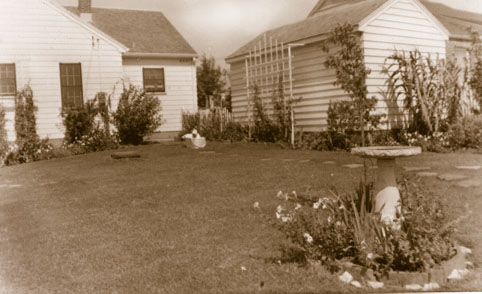 |
||||||||||||||||||||||||||||||
| Thelma's husband Skeet carved a large Indian head into the rock and the girls traced the outline repeatedly to preserve it in the rock. It was a wonderful yard, full of fragrant flowers most summers. There was always work to do in the yard. When the girls were older they could earn 25 cents for pulling a bushel basket full of weeds.
Vi and Willard brought their new baby daughter to this home. Willard often commented humorously that the saying 'Life begins at 40' was not always true. Because of Judy's birth on his birthday( In 1940), he would frequently say, "For me, life ended at 40." [Note: December 24 was also the birth date of Vi's sister, Elizabeth Platt Bradley. Elizabeth sometimes visited for the holidays and a 'three-way celebration' of the joint birthdays.] It was convenient to have sisters who were nurses. Nora helped with Judy's delivery and later Elizabeth was the nurse when Martha was delivered and when Judy's tonsils were removed . Willard was thrilled to have finally become a parent. He doted on his family, indulging his children and bragging on their brilliance to any who would listen. Vi had taught for many years and had an excellent rapport with children. She knew countless games. She loved all children and listened with a willing ear to hours of chatter. Martha remembers coming home from school and rushing in to talk to Mother for long periods while Mom fixed dinner and listened with rapt attention! |
||||||||||||||||||||||||||||||
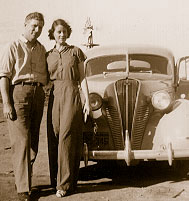 |
||||||||||||||||||||||||||||||
| In November 1942, Judy visited on the farm of Vi's sister Annabelle (and Ben) Fugate, near Orlando, Oklahoma, while Vi was in the hospital having her 2nd child, Martha Lou, who was born on November 16.
Vi was the quieter parent, at least as far as talking went. She sang and whistled more than she talked. She was about 5' 5" tall, with fine brown hair. She was always slim, never weighing more than about 125 (and much less than that in her later years). She usually kept a permanent in her hair and she always wore it short. Her sisters talk about how stylish she was as a young single schoolteacher, and there are many old photos of Vi with her hair fixed in 'marcel' or finger waves, wearing the latest fashions. Later she wore Nellie Don rayon jersey housedresses, in colorful floral prints. These were easy care, comfortable, and the front buttons and zippers were easy for her to manage after arthritis crippled her fingers. |
||||||||||||||||||||||||||||||
| Willard worked for a while in the 1940's from his residence, making and receiving phone calls regarding rail shipments of oil and other material for Phillips. This work involved calls at all hours of the day or night, all days of the week, to keep track of needed material and be certain that freight cars arrived on schedule as needed. This was before modern pipeline systems. It was very hard work for Vi, with two small babies to keep very quiet, to have Willard working from the home using the phone at all hours of the day and night. He soon returned to the office to work and things went back to normal. There were always an animal or two (or 20) around the house when Judy and Martha were growing up - dogs, cats, chickens, rabbits, you name it. One year a summer vacation trip to California was planned. After counting up the pets to be boarded out, the trip was canceled. They had a beautiful American Spitz named Kitri, with long white hair. Vi heard that the long hairs could be woven into scarves or blankets, so when spring arrived and Kitri was sheared for the summer, the fur was saved in plastic bags in the attic. Several years later, on a hot summer day, the attic fan was turned on and the deteriorated bags spread Kitri's bushels of hair over the entire attic. |
||||||||||||||||||||||||||||||
|
After her two girls were established in elementary school, Vi began to wish she could contribute to her family's income, and to recall how she loved her career as a teacher. She began to plan for a pre-school that she could operate from the family home while her children were away from school. In approximately 1950 she began the first pre-school in Bartlesville and possibly the first in the state of Oklahoma. A class was offered for about a dozen 3 year old children two mornings each week, and a similar class for four year olds on alternate mornings. The school was operated to coincide with the public school year and continued until after Willard retired from Phillips in 1961. When her girls were still at home, Vi would entertain her family at mealtime with some of the funny things the children had said or done at pre-school that day. It was her family's favorite part of the day! During a trip to California she studied methods used in pre-schools in the Los Angeles area. Her little students adored her, and their early preparation for school led them to be classroom stars as they progressed on through their schooling. They enjoyed putting on puppet shows, learning to count and recognise ABC's, and on the last day of pre-school they traditionally prepared and helped to crank a freezer of homemade ice cream. Vi always had long waiting lists for openings in her pre-school! |
||||||||||||||||||||||||||||||
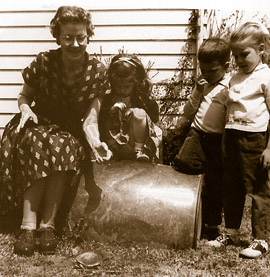 |
||||||||||||||||||||||||||||||
|
Vi, her pet turtle and pre-schoolers
|
||||||||||||||||||||||||||||||
| Soon after, she began to have migraine headaches and began to show symptoms of rheumatoid arthritis. Both of these plagued her until her death in 1980. Vi was not a person who complained. When ferocious migraines made her ill she retired to her bedroom where she closed the door, turned off the lights, closed the blinds, and stayed until she recovered - sometimes a period of a few days. The family did not disturb her when she suffered. Rheumatoid arthritis can be a very crippling and disabling disease, but Vi found ways to accomplish tasks despite her arthritis, inventing many 'gadgets' and devices to assist her in tasks that her crippled hands and other joints could not manage. She almost never asked for help, but would 'figure out a way' to do anything. Although the arthritis was very painful, there was never a complaint of the pain and only infrequently was she seen to wince. She had problems with her feet (including bunions) and had foot surgery in about 1950, removing her small toe. The surgery made her problems worse, and contributed to the pain in her feet for the remainder of her life. She was unable to wear most shoes, and tried a variety of special shoes to ease the pain. After her Doctor told her she would be in a wheel chair soon, her brothers and sisters pooled financial resources to surprise her with a pair of custom- | 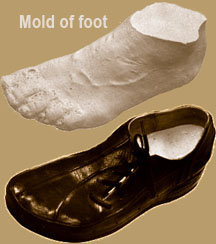 |
|||||||||||||||||||||||||||||
|
Murray Space Shoes
|
||||||||||||||||||||||||||||||
| made, molded to her feet, and very expensive "Murray Space Shoes", sending their contributions with loving cards thanking her for the many ways she'd helped them over the years. The 'space shoes' were like miracle shoes that allowed her to get around more comfortably than any other shoes. Vi wore them (with repairs and new soles) for many years, and then ordered replacements when the originals finally wore out. That first pair was the best; never again would she walk with any degree of comfort.
Willard had rheumatic fever as a child and as a result had a weak heart his entire life. a He took medicine for it, plus diabetes and high blood pressure. He died in Bartlesville, August 7, 1968, at age 67, of a stroke. As the years continued, Vi began to have circulatory problems similar to those experienced by diabetics, although repeated tests failed to diagnose diabetes. (Later it was shown to be caused by her rheumatoid arthritis.) She had severe lung congestion which was diagnosed as emphysema, but which was again proved to be yet another side effect of her rheumatoid arthritis. In 1977 the circulatory problems led to gangrene in her lower leg, and she ultimately required amputation of that leg above the knee. As always, she made no complaints and made a valiant effort to learn to use an artificial leg, which nearly outweighed her. She lacked the physical strength to be very successful with the leg, and accepted life in a wheelchair with good humor. When she was able to get a battery-powered wheelchair she joked about getting a 'learner's permit' for driving the chair. When she had to move into a nursing home she loved the long hallways where she could race from one end to the other as fast as the wheelchair could go, unrestricted by any furniture. . and she said it reminded her of the freedom she always felt in her Model A Convertible. Demonstrations were always in order. In her final years she was diagnosed with a skin cancer on her nose; the initial surgery was inadequate, and a second surgery left a small hole into her nostril that she usually covered with a small band-aid, accepting further indignity with her usual grace. Like her Mother, Vi was diagnosed with breast cancer and had a mastectomy, but thankfully, no further treatment was required. She died in December of 1981 of lung problems and heart failure. She and Willard are buried with all of his family in Rose Hill Cemetery in Tulsa, OK. |
||||||||||||||||||||||||||||||
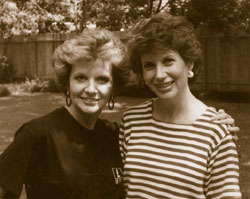 |
||||||||||||||||||||||||||||||
|
Vi's Children, Martha and Judy.
(in the Late 1980s) |
||||||||||||||||||||||||||||||